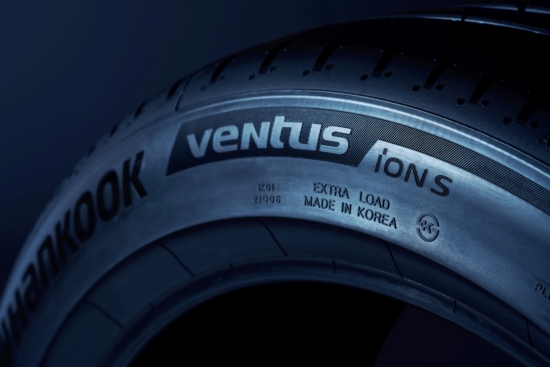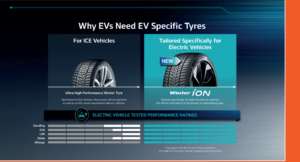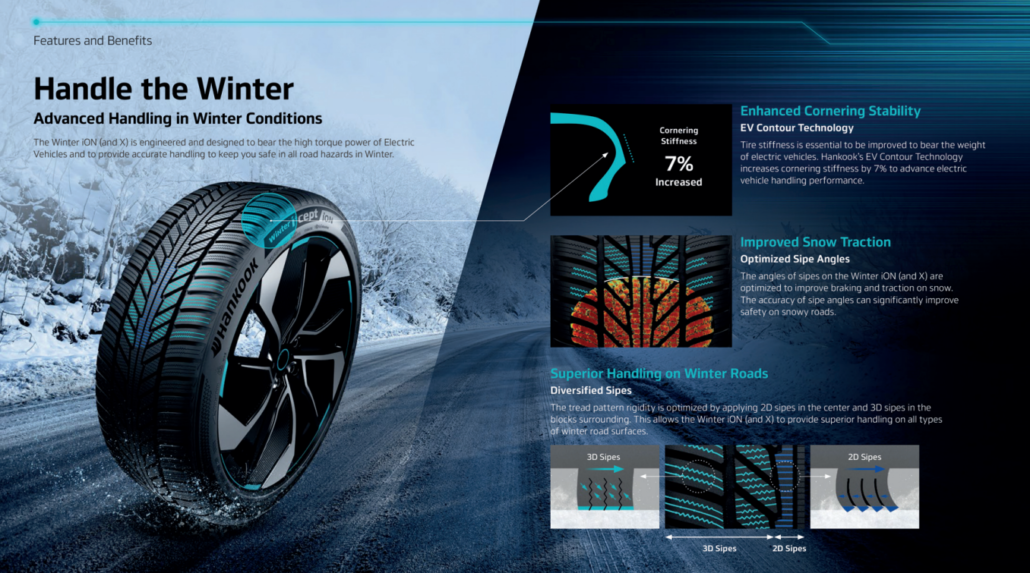Hankook iON: the new global tyre family for EVs
 Hankook Ventus iON S summer tyre (Photo: Hankook)
Hankook Ventus iON S summer tyre (Photo: Hankook)
Earlier this year Hankook introduced its iON range of electric vehicle (EV) tyres to the world. Here, the global tyre maker gives us a unique insight into the company’s ground-breaking range.
Why does an electric vehicle need different tyres than a vehicle with combustion engine?
Compared to conventional tyres, EV tyres must meet four specific requirements:
- They have to offer a particularly low rolling resistance so that the vehicle can travel as far as possible with one battery charge.
- They should add to the high degree of noise comfort offered by electric cars (thus be as quiet as possible).
- They need to be designed to handle very high levels of torque from standstill without generating excessive wear.
- They have to be designed to suit the higher masses of electric vehicles, due to the heavier weight of EV batteries.
Tyres in the Hankook iON family score top marks in all categories.
How does Hankook achieve these product properties?
One factor for the improvement in rolling resistance is due to the weight savings of up to one kilogram per tyre. This is achieved using natural oils, which ensure less abrasion; less material is therefore required on the tread to achieve the same mileage. These oils are also more environmentally friendly. Aerodynamic optimisation also ensures a greater range per battery charge. The tyre pattern is therefore designed in such a way that air resistance is also reduced. This even applies to the lettering on the tyre sidewalls.
In addition, the tread compounds on the iON series also have a huge impact on the rolling resistance: highly dispersible polymers, a high proportion of silica and a modern mixing process all result in greater tread elasticity, while also reducing the unnecessary movement in the tread. This reduces energy loss and thus rolling resistance. A test performed by TÜV SÜD[1] shows that the Hankook Ventus iON S – fitted on popular premium electric vehicles – is clearly superior to conventional tyres, especially in terms of rolling resistance.
Hankook Sound Absorber™ technology and the design of the tyre pattern are the main factors in achieving a particularly low noise level. This is especially important for electric cars, since there is no combustion engine to produce noise, meaning other sources of noise are noticed all the more clearly.
Hankook iON tyres are specifically designed for the high torques of electric vehicles. It is possible to accelerate from a standstill with reduced wheel slip – the tyre provides the necessary grip. The tread compound contains a high proportion of natural resin, which ensures exemplary durability and reduced wear.
Finally, Hankook has addressed the larger vehicle mass of electric cars with a load distribution that is adapted to higher load capacity over the entire width of the tread. Lasting stability is made possible with the extra-resistant aramid fibres, which effectively counteract deformation.
Doesn’t low rolling resistance as a primary development goal conflict with other, safety-related development goals?
Safety is the top priority for road vehicles – there must be no compromise in this regard.
With the iON, the Hankook engineers have brilliantly solved the conflict between minimising rolling resistance while maintaining the same qualities in other important criteria such as handling and wet braking performance, as the TÜV SÜD test proves. Fitted on popular premium electric vehicles, the Hankook Ventus iON S was clearly superior, especially in terms of rolling resistance: at the same time, it did not deviate from competitor benchmark specifications by more than 6% in any criterion; it even achieved top scores for wet and dry braking performance.
Using natural resin helps to maintain a good grip in the wet, despite the low rolling resistance. Also of particular note is the high silica content of the iON, which provides micro-level grip on wet roads by counteracting the formation of a film of water between the road surface and the tyres, which can be dangerous.
For which variants does Hankook offer the new iON tyre?
The iON products will initially be available in three designs at market launch, in sizes from 18 to 22 inches: from May 2022 in Europe for the Hankook Ventus iON S summer tyre profile and from September 2022 for the Hankook Winter i*cept iON. The Hankook Ventus iON A tyre will be available as an all-season version for the North American market. Further specific product designs are currently in the pipeline.
The new developments are intended to help advance the energy revolution, making electromobility even more sustainable. How will this work?
Compared to standard tyres it is possible to achieve more kilometres per battery charge with the Hankook iON. This is a significant step forward in people accepting electric vehicles – and reducing a common worry about their range – as well as reducing CO2 emissions from road traffic.
The relevance will continue to increase according to current forecasts: According to the information service IHS Markit, the global share of battery-powered electric vehicles in total vehicle sales will increase from the current 6.4% market share to 29.5% by 2028. This means that, in addition to the market share for the original equipment, the replacement demand for electric vehicles is also growing.
[1] TÜV SÜD Tire Test 2022, Report No. 713252186-BM01, -PM01. Test period March 2022. Test of the Hankook Ventus iON S with four competitor tyres, all in the dimension 245/45 ZR19 102Y XL. Test vehicles Tesla Model S 85, Tesla Model S P100D, Audi Q5 Sportback 40 TDI, VW Tiguan 2.0 TDI. Test locations: IDIADA, Papenburg, Neubiberg, Garching. Applies to all other mentions of the TÜV SÜD Tire Test.





Comments